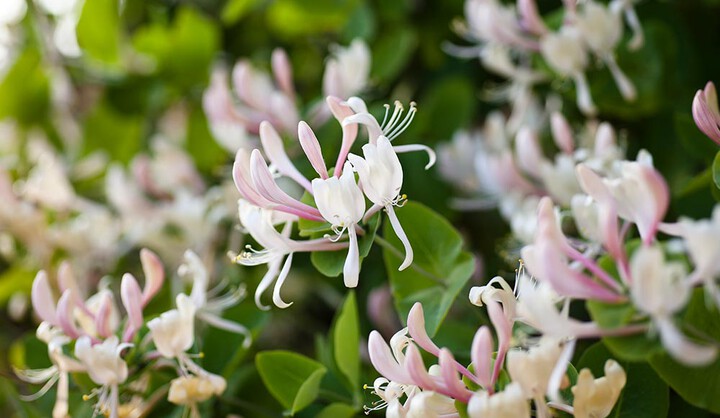
Honeysuckle is known for its delicate tubular, nectar-filled, sweetly scented flowers. They are great for covering walls and the sides of building. While their roots should be shaded, they do best when their overflowing, flowering tops are mostly in sunlight or just slightly shaded. They are deer-resistant and hummingbirds and other wildlife love them.
Wondering how to grow honeysuckle? Read on for everything you need to know about this easy-to-grow plant, from popular varieties to how and when to plant honeysuckle. We’ll cover:
What is Honeysuckle?
Honeysuckle is a heat tolerant plant that can grow almost anywhere. With dark green to blue-green leaves and sweet-smelling flowers, they grow as either far-reaching vines or arching shrubs. The flowers can bloom in gorgeous bright pinks, oranges, yellows or whites, and some varieties have a unique two-colored flower. Sweet and nectar-filled, the flowers attract butterflies, hummingbirds and bees, and birds enjoy the small red berries that emerge after flowering. If care is taken to deadhead, these beauties can repeat-bloom often throughout the growing season.
Popular Types of Honeysuckle
There are close to 200 different varieties of honeysuckle. Native to the northern hemisphere, at least 20 of them are found in North America. There are three types of honeysuckle – vines, shrubs and a bush variety.
Honeysuckle Vines. The honeysuckle vine is a common, simple-to-grow climber that’s available in many varieties. Vines can also be planted as ground cover, but they’re most often trellis-trained to cover walls and structures.
Honeysuckle Shrubs. The honeysuckle shrub is a great choice to use as an informal hedge, and several shrub varieties will actually do surprisingly well in pots and containers.
Bush Honeysuckle. One of the more invasive types of honeysuckle, bush honeysuckle should not be planted in your garden or yard. Bush honeysuckle grows quickly, invading and shading out other areas of your garden.
Specific Types of Honeysuckle
·Trumpet Honeysuckle. One of the most popular types of honeysuckle vines, the trumpet honeysuckle is also called coral or scarlet honeysuckle. Native to North America, it does well in the southern states with spring to fall blooms in pink or red hues. Likes sun to partial shade and is drought tolerant (although it thrives in moist soil). Non-invasive.
·Japanese Honeysuckle. The Japanese honeysuckle vine thrives in the Midwest. It blooms red or pink blossoms that show up in the summer and continue to delight all the way through early fall. Can be grown as a ground cover or trained on a trellis. Extremely invasive.
·Winter Honeysuckle. Winter honeysuckle is a shrub with white flowers that open in late winter or early spring. They have a lemony smell and do well in pots or containers. Highly invasive in some areas.
·Sakhalin Honeysuckle. Another shrub, Sakhalin honeysuckle is very similar to Winter honeysuckle, but has deep red flowering blooms. Non-invasive.
·White Limestone Honeysuckle. Also known as Texas honeysuckle, this shrub grows in full sun to partial shade and has showy, white-clustered flowers. Not as invasive as Japanese honeysuckle.
·Honeyberry. With more of a long, blue, berry-shape and small white, fragranced flowers, this edible variety is also called an edible blue honeysuckle. Honeyberry does better in cooler-climates. Non-invasive.